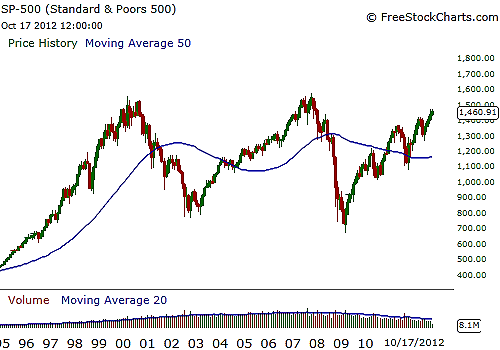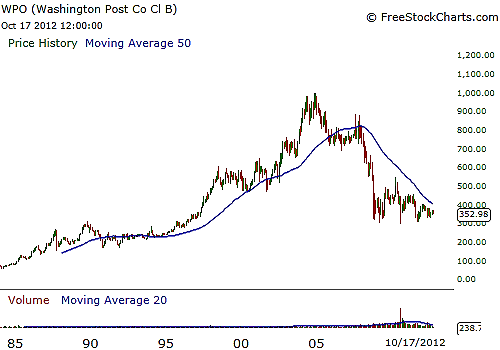
HOT TOPICS LIST
- MACD
- Fibonacci
- RSI
- Gann
- ADXR
- Stochastics
- Volume
- Triangles
- Futures
- Cycles
- Volatility
- ZIGZAG
- MESA
- Retracement
- Aroon
INDICATORS LIST
LIST OF TOPICS
PRINT THIS ARTICLE
by Billy Williams
There is a lot of uncertainty in today's market so you need to have a game plan for all time frames to maximize your opportunities.
Position: Hold
Billy Williams
Billy Williams has been trading the markets for 27 years, specializing in momentum trading with stocks and options.
PRINT THIS ARTICLE
STRATEGIES
Value; A Professional's Market; 2013; And Beyond
10/22/12 09:12:33 AMby Billy Williams
There is a lot of uncertainty in today's market so you need to have a game plan for all time frames to maximize your opportunities.
Position: Hold
| To date, economic forecasts remain gloomy as GDP estimates for the year at 1.7% have been revised downward to 1.3% and, worse, the International Monetary Fund has revised global growth estimates down for 3.6% to 3.3%. Jim Rogers, former partner of George Soros at Quantum Fund, has even been quoted as saying that a recession is all but in the works as the economic forecasts for 2013 and 2014 give little hope of an economic recovery here at home and even less overseas except for a few sectors in Asia. If these forecasts are to be believed, then this remains a professionals' market where the skilled, well-capitalized, and nimble traders will continue to dominate the upper-end of high performance in today's economic environment. However, this doesn't mean a drag on the current market's price action, at least not in the short- to intermediate-term future, as the cheap money being printed by QE3 from the Fed will continue to support inflation-sensitive sectors as well as the stock market that will price in such inflation and cause it to rise. |

|
| FIGURE 1: SPX. The SPX is trading at the upper end of its all-time high, but weak economic conditions could cause it to crash. |
| Graphic provided by: www.freestockcharts.com. |
| |
| But eventually the market's price action will be unable to outrun its fundamentals such as rising deficits, high unemployment, and falling household income. When it does, the market will crash and you can count on value-oriented approaches coming back in favor. See Figure 1. As the market falls, taking stock prices with it, you can time your entry into the market by using a combination of factors and indicators, but one of the surest signs is when all the talking heads on the financial news networks sing in unison on how unattractive stocks are to own. Once that happens, that is usually the time to scan the market for attractive stocks whose companies have a durable competitive advantage and a high quality of earnings. |

|
| FIGURE 2: WPO. Warren Buffett made billions by buying companies with a strong durable competitive advantage at a good value like with the Washington Post. A $50 million investment in the late 1970s developed into a $1.4 billion windfall for the Oracle of Omaha. |
| Graphic provided by: www.freestockcharts.com. |
| |
| Benjamin Graham, the founder of value investing, believed that once a stock had fallen below its intrinsic value, then it was his approach to buy with a high margin of safety. For example, if a stock's intrinsic value was at $50 a share, then Graham would try to buy the stock with a margin of safety of 66% of the intrinsic value, which would make this stock a buy at $33 a share. |
| Once the stock had risen to 50%, Graham would sell quickly. Using this approach, he averaged 17% annually during the 1930s and 1940s during a time where the market was still affected by the trauma of the Great Depression. One of Graham's students, Warren Buffett, used this approach early in his career but then formulated the theory of selecting stocks in good companies that had a strong durable competitive advantage that acted as a moat and protected a company from competitors, economic downturns, and falling earnings (Figure 2). This was why he took such a big position in the "Washington Post" during the 1970s since the newspaper was below its intrinsic value but had a near monopoly on the advertising in its region compared to other periodicals. Buffett's investment of just under $50 million is now worth upward of $1.4 billion! |
| The point is that given the current economic reality as well as the future economic forecasts, it pays to trade in the short- to intermediate-term time frames. If the market crashes, then be prepared to buy up solid high-dividend blue-chip companies with little to no debt, high earnings, and a strong durable competitive advantage when others are scared to act. That is how players like Buffett and other investment greats got rich, and you can too. |
Billy Williams has been trading the markets for 27 years, specializing in momentum trading with stocks and options.
| Company: | StockOptionSystem.com |
| E-mail address: | stockoptionsystem.com@gmail.com |
Traders' Resource Links | |
| StockOptionSystem.com has not added any product or service information to TRADERS' RESOURCE. | |
Click here for more information about our publications!
PRINT THIS ARTICLE

|

Request Information From Our Sponsors
- StockCharts.com, Inc.
- Candle Patterns
- Candlestick Charting Explained
- Intermarket Technical Analysis
- John Murphy on Chart Analysis
- John Murphy's Chart Pattern Recognition
- John Murphy's Market Message
- MurphyExplainsMarketAnalysis-Intermarket Analysis
- MurphyExplainsMarketAnalysis-Visual Analysis
- StockCharts.com
- Technical Analysis of the Financial Markets
- The Visual Investor
- VectorVest, Inc.
- Executive Premier Workshop
- One-Day Options Course
- OptionsPro
- Retirement Income Workshop
- Sure-Fire Trading Systems (VectorVest, Inc.)
- Trading as a Business Workshop
- VectorVest 7 EOD
- VectorVest 7 RealTime/IntraDay
- VectorVest AutoTester
- VectorVest Educational Services
- VectorVest OnLine
- VectorVest Options Analyzer
- VectorVest ProGraphics v6.0
- VectorVest ProTrader 7
- VectorVest RealTime Derby Tool
- VectorVest Simulator
- VectorVest Variator
- VectorVest Watchdog
